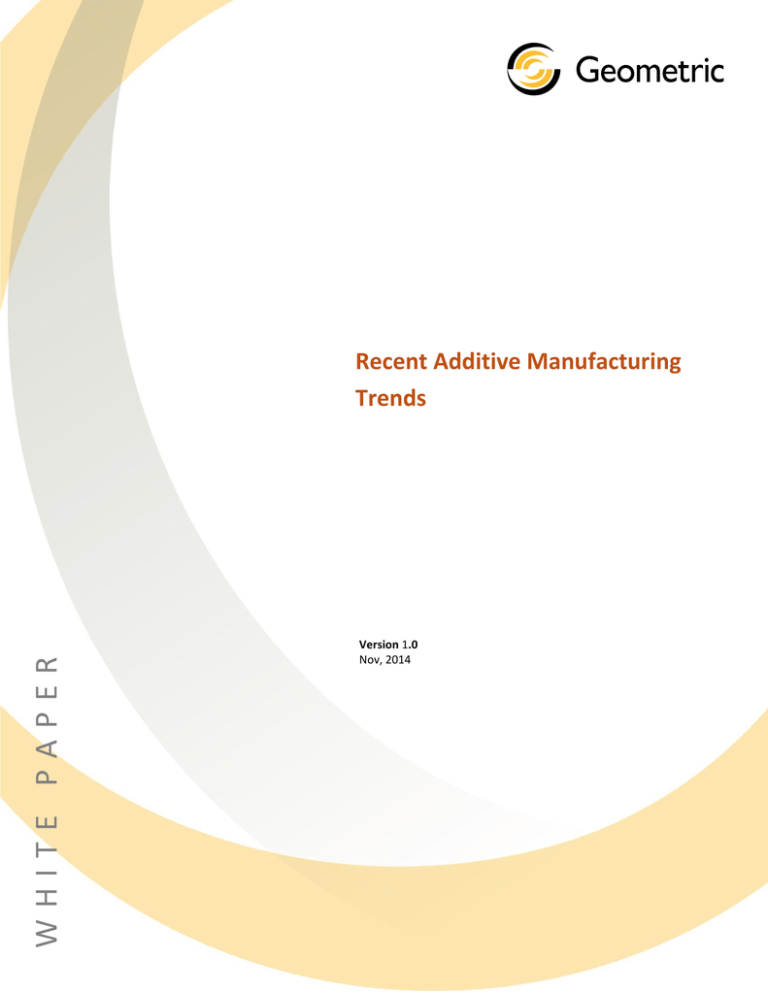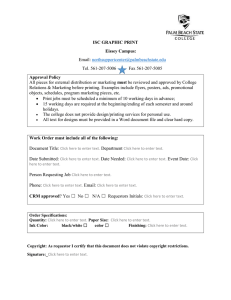
WHITE PAPER
Recent Additive Manufacturing
Trends
Version 1.0
Nov, 2014
Copyright Notice
© Geometric Limited. All rights reserved.
No part of this document (whether in hardcopy or electronic form) may be reproduced, stored in a retrieval
system, or transmitted, in any form or by any means, electronic, mechanical, photocopying, recording, or
otherwise, to any third party without the written permission of Geometric Limited. Geometric Limited
reserves the right to change the information contained in this document without prior notice.
The names or trademarks or registered trademarks used in this document are the sole property of the
respective owners and are governed/ protected by the relevant trademark and copyright laws.
This document is provided by Geometric Limited for informational purposes only, without representation or
warranty of any kind, and Geometric Limited shall not be liable for errors or omissions with respect to the
document. The information contained herein is provided on an “AS-IS” basis and to the maximum extent
permitted by applicable law, Geometric Limited hereby disclaims all other warranties and conditions, either
express, implied or statutory, including but not limited to, any (if any) implied warranties, duties or conditions
of merchantability, of fitness for a particular purpose, of accuracy or completeness of responses, of results,
of workmanlike effort, of lack of viruses, and of lack of negligence, all with regard to the document.
THERE IS NO WARRANTY OR CONDITION OF NON-INFRINGEMENT OF ANY INTELLECTUAL PROPERTY RIGHTS
WITH REGARD TO THE DOCUMENT. IN NO EVENT WILL GEOMETRIC LIMITED BE LIABLE TO ANY OTHER PARTY
FOR LOST PROFITS, LOSS OF USE, LOSS OF DATA, OR ANY INCIDENTAL, CONSEQUENTIAL, DIRECT, INDIRECT,
OR SPECIAL DAMAGES WHETHER UNDER CONTRACT, TORT, WARRANTY, OR OTHERWISE, ARISING IN ANY
WAY OUT OF THIS DOCUMENT, WHETHER OR NOT SUCH PARTY HAD ADVANCE NOTICE OF THE POSSIBILITY
OF SUCH DAMAGES.
Confidentiality Notice
This document is disclosed only to the recipient pursuant to a confidentiality relationship under which the
recipient has confidentiality obligations defined herein after. This document constitutes confidential
information and contains proprietary information belonging to Geometric Limited, and the recipient, by its
receipt of this document, acknowledges the same. The recipient shall use the confidential information only
for the purpose defined above for which this document is supplied. The recipient must obtain Geometric
Limited’s written consent before the recipient discloses any information on the contents or subject matter of
this document or part thereof to any third party which may include an individual, firm or company or an
employee or employees of such a firm or company. The recipient acknowledges its obligation to comply with
the provisions of this confidentiality notice.
2
Contents
Introduction ............................................................................................................ 4
Bio-inspired light weight designs for engineering applications .............................. 4
Carbon fibre reinforced plastic (CFRP) printing ...................................................... 4
Smart part manufacturing with 3D electronics printing and AM ........................... 5
Hybrid AM and milling machines ............................................................................ 5
Conclusion ............................................................................................................... 5
About the Author .................................................................................................... 6
About Geometric .................................................................................................... 7
3
Introduction
Additive Manufacturing (AM) has been there for many decades now. It has seen greater attention
and wide spread awareness in the past few years due to affordable machines, innovative materials
and the rise of AM service providers. Today AM has a footprint in all major industries – from
aerospace and automotive to medical implants and fashion. Additive manufacturing refers to a
process by which digital 3D design data is used to build up a component in layers by depositing
material. Additive manufacturing (AM) techniques such as Fused Deposition Modeling (FDM),
Stereolithography (SLA), PolyJet (3DP), Selective Laser Sintering (SLS), Direct Metal Laser Sintering
(DMLS) are used to manufacture parts. AM applications for non-engineering and domestic
applications include hobbyist printing, gift article printing, ceramic printing, chocolate printing,
bio-printing human organs, etc. For engineering applications, AM is mainly used for prototype
manufacturing, tool manufacturing and end-use part manufacturing. Use of AM technologies for
engineering applications will open up many new possibilities of improving the form, functionality
and economics of a product. The most significant change that industries need to address today is
the adoption of Additive Manufacturing (AM) in our design and manufacturing engineering
processes. Use of AM is seeing new frontiers like printing bio-inspired light weight designs for
aerospace and automotive applications, carbon fibre reinforced plastic printing, smart part
manufacturing by 3D electronics printing and AM, hybrid machines with metal laser sintering and
milling capabilities, electron beam melting for AM, laser melting and deposition, AM pattern
printing for investment casting, etc. Let us look at some dimensions of the following AM
techniques:
Bio-inspired light weight designs for engineering applications
The new lightweight parts created from AM take inspiration from human bone structure. Human
bones have internal regions with different levels of porosity covered with hard outer layers with
varying thickness. Regions where higher loads are frequently encountered have denser porosity
levels and thicker outer layers. Similar methodology is adopted for designing parts to create lighter
yet stronger parts. AM renders printing solid parts with internal honeycomb or scaffolds with few
layers of outer skin. New analysis tools claim to optimize parts automatically with varying scaffold
thickness and outer skin thickness in various regions depending on load conditions. There have
been rapid improvements in this area and we may have a suite of new bio-inspired light weight
parts in aerospace and automobile applications. Such methodologies will help designing parts to
take unique advantages of AM process rather than printing parts that are designed for
conventional manufacturing processes.
Carbon fibre reinforced plastic (CFRP) printing
Multi-material printers are capable of printing more than one material and make a composite
structure consisting of two different materials such as a part with harder core and a rubbery outer
layer. A recent advancement in multi-material printing is that a new AM machine can print CFRP
with plastic extrusion printer that can lay up continuous carbon fibers in between layers. This has
4
opened up new avenues for printing much stronger materials using AM. This technology could
bring in more automation in creating different types of reinforced plastics for aerospace and
automobile applications in future. We could even envisage 3D FRP printers in future integrated
with software technologies, taking 3D model as an input and automatically creating a fiber lay-up
for a part depending on different loading conditions.
Smart part manufacturing with 3D electronics printing and AM
Smart parts, manufactured using AM, with integrated conformal 3D electronic circuits were
demonstrated by printing the part with plastic extrusion and printing electronics on the 3D part by
a leading AM technology company. Such technologies could mature in future to 3D print a
complete part with electronic circuitry in a single integrated machine having software capabilities
to facilitate integrated designing and printing of both the mechanical part and electronic circuits.
Hybrid AM and milling machines
Surface finish of additive manufactured parts has all along been an issue in successful adoption of
AM technology for hard core engineering applications. Printed metal parts often require secondary
operations. To counter this issue, leading precision machine tool companies are introducing hybrid
machines with AM and milling capabilities. One such example is a machine with metal laser
sintering unit that creates the part layer by layer and also has an integrated high speed milling
head which can machine layer by layer during the additive layer processing itself. After every layer
is created, the layer is machined to ensure smooth surface quality. This hybrid combination can be
very useful in making molds with 3D conformal cooling channels and porous sections for gas
venting which cannot be manufactured by other processes. We clearly see this technology
maturing in future with CAM software capabilities to machine only selective regions in each layer,
selective finish machining, etc.
Conclusion
AM techniques can be truly transformative for manufacturing organizations, cutting time, reducing
waste, and bringing in unmatched efficiencies to create products. Geometric is taking its first steps
in working with the ecosystem to address challenges in AM application for industrial systems and
production use.
5
About the Author
Dr. Kannan has over 20 years of R&D experience in CAD/CAM, engineering
software development, and manufacturing automation. He has a Ph.D. in
computer integrated manufacturing and process planning. He has published
multiple research papers in renowned international journals and conferences in
related areas. His area of expertise includes product development and R&D for
next generation CAD/CAM software products. He can be contacted at
TR.Kannan@geometricglobal.com.
Disclaimer
Author and Geometric Ltd respects the Intellectual Property Rights for every source it refers to.
Care has been taken to ensure that credits are mentioned. However, it is possible for some of the
things to be overlooked. If any such thing is observed, it is purely incidental and it is a sincere
request to bring it the notice of the author.
References
1.
2.
3.
4.
5.
6.
http://www.withinlab.com/
http://www.3dsystems.com/projet5500x
https://markforged.com/
http://www.optomec.com/
http://www.lumex-matsuura.com/
http://ca-en.dmgmori.com/products/lasertec/lasertec-additivemanufacturing/lasertec-653d
6
About Geometric
Geometric is a specialist in the domain of engineering solutions, services and technologies. Its
portfolio of Global Engineering services, Product Lifecycle Management (PLM) solutions,
Embedded System solutions, and Digital Technology solutions enables companies to formulate,
implement, and execute global engineering and manufacturing strategies aimed at achieving
greater efficiencies in the product realization lifecycle.
Listed on the Bombay and National stock exchanges in India, the company recorded consolidated
revenues of Rupees 10.95 billion (US Dollars 181.39 million) for the year ended March 2014. It
employs about 4400 people across 13 global delivery locations in the US, France, Germany,
Romania, India, and China. Geometric was assessed as CMMI 1.1 Level 5 for its software services
and is ISO 9001:2008 certified for engineering operations. The company’s operations are also ISO
27001:2005 certified.
The copyright/ trademarks of all products referenced herein are held by their respective companies.
7



